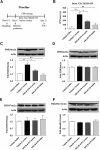Arginine Methyltransferase 1 in the Nucleus Accumbens Regulates Behavioral Effects of Cocaine
- PMID: 26377474
- PMCID: PMC6795199
- DOI: 10.1523/JNEUROSCI.0246-15.2015
Arginine Methyltransferase 1 in the Nucleus Accumbens Regulates Behavioral Effects of Cocaine
Abstract
Recent evidence suggests that histone modifications play a role in the behavioral effects of cocaine in rodent models. Histone arginine is known to be methylated by protein arginine N-methyltransferases (PRMTs). Evidence shows that PRMT1 contributes to >90% of cellular PRMT activity, which regulates histone H4 arginine 3 asymmetric dimethylation (H4R3me2a). Though histone arginine methylation represents a chemical modification that is relatively stable compared with other histone alterations, it is less well studied in the setting of addiction. Here, we demonstrate that repeated noncontingent cocaine injections increase PRMT1 activity in the nucleus accumbens (NAc) of C57BL/6 mice. We, subsequently, identify a selective inhibitor of PRMT1, SKLB-639, and show that systemic injections of the drug decrease cocaine-induced conditioned place preference to levels observed with genetic knockdown of PRMT1. NAc-specific downregulation of PRMT1 leads to hypomethylation of H4R3me2a, and hypoacetylation of histone H3 lysine 9 and 14. We also found that H4R3me2a is upregulated in NAc after repeated cocaine administration, and that H4R3me2a upregulation in turn controls the expression of Cdk5 and CaMKII. Additionally, the suppression of PRMT1 in NAc with lentiviral-short hairpin PMRT1 decreases levels of CaMKII and Cdk5 in the cocaine-treated group, demonstrating that PRMT1 affects the ability of cocaine to induce CaMKII and Cdk5 in NAc. Notably, increased H4R3me2a by repeated cocaine injections is relatively long-lived, as increased expression was observed for up to 7 d after the last cocaine injection. These results show the role of PRMT1 in the behavioral effects of cocaine.
Significance statement: This work demonstrated that repeated cocaine injections led to an increase of protein arginine N-methyltransferase (PRMT1) in nucleus accumbens (NAc). We then identified a selective inhibitor of PRMT1 (SKLB-639), which inhibited cocaine-induced conditioned place preference (CPP). Additionally, genetic downregulation of PRMT1 in NAc also attenuated cocaine-caused CPP and locomotion activity, which was associated with decreased expression of histone H4 arginine 3 asymmetric demethylation (H4R3me2a) and hypoacetylation of histone H3 lysine 9 and 14 (acH3K9/K14). This study also showed that H4R3me2a controlled transcriptions of Cdk5 and CaMKII, and that PRMT1 negatively affected the ability of cocaine to induce CaMKII and Cdk5 in NAc. Notably, increased H4R3me2a by repeated cocaine injection was relatively long-lived as increased expression was observed up to 7 d after withdrawal from cocaine. Together, this study suggests that PRMT1 inhibition may serve as a potential therapeutic strategy for cocaine addiction.
Keywords: PRMT inhibitor; behavioral plasticity; cocaine; histone arginine methylation; protein arginine N-methyltransferase 1.
Copyright © 2015 the authors 0270-6474/15/3512891-13$15.00/0.
Figures







References
-
- Bissinger EM, Heinke R, Spannhoff A, Eberlin A, Metzger E, Cura V, Hassenboehler P, Cavarelli J, Schüle R, Bedford MT, Sippl W, Jung M. Acyl derivatives of p-aminosulfonamides and dapsone as new inhibitors of the arginine methyltransferase hPRMT1. Bioorg Med Chem. 2011;19:3717–3731. doi: 10.1016/j.bmc.2011.02.032. - DOI - PubMed
Publication types
MeSH terms
Substances
Associated data
- Actions
- Actions
- Actions
- Actions
- Actions
LinkOut - more resources
Full Text Sources
Molecular Biology Databases
